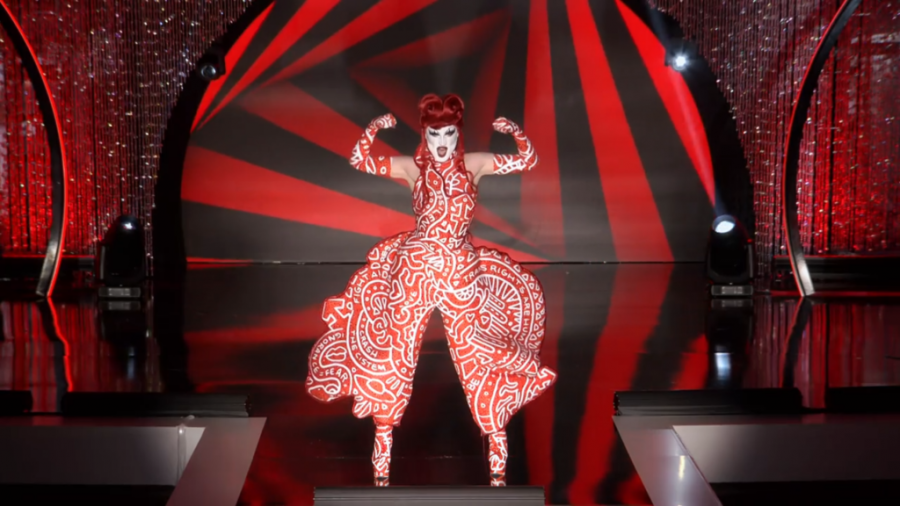Gottmik’s casting on “RuPaul’s Drag Race” offers exposure to unrepresented perspectives
Trans men have been largely erased from queer stories and it’s time to change that
Third place queen of Season 13 of “RuPaul’s Drag Race,” Gottmik also known as Kade Gottlieb, represents trans men in the finale with a beautiful statement gown inspired by queer icon Keith Haring. (Photo courtesy of World of Wonder)
As a trans man, never seeing myself represented in popular media has been an obstacle in the development of my gender identity and presentation. We in the community get to see our trans sisters represented on television shows like “Orange is the New Black” and “Pose.”
Despite the occasionally questionable handling of their transitions and a cis-sexist tendency toward punishing their non-cisgender or heterosexual characters in these pieces, the visibility of trans women is without a doubt on the rise. However, even in stories about our community, our trans brothers and transmasculine and nonbinary family are erased and underrepresented. Visibility and representation are key to identity development and we more than deserve to be seen.
Feminine trans man and alternative drag queen Gottmik’s appearance on “RuPaul’s Drag Race” this year marked the first time I’d ever seen someone like me on TV. Trans men are missing from the media landscape, aside from a questionable take on trans masculinity portrayed on “Shameless” and a few minor plotlines on other shows.
The character in “Shameless” is written as defensive, hypermasculine and temperamental and his fleeting role in the story, as a love interest, is designed so he can introduce the idea of trans identity and queerness to the rough and tumble gay son of the Gallaghers, all while enduring every uncomfortable and transphobic interaction trans men constantly face, defining his character by his gender and denying him any depth.
This role was played by the charming and actually trans Elliot Fletcher, who played another trans masculine role in “The Fosters,” and while in both roles, the actor had to advocate for accurate representation himself, ensuring the portrayal of his group wasn’t distorted by writers who didn’t do their research.
While trans men and nonbinary people are slowly moving in on the outskirts of media, seeing a trans man prominently featured on one of my favorite shows, who looked like me and shared my experience as a feminine trans man, fascinated by the art of drag and the beauty of playing with gender as the performance that it is, made a huge impact on me.
I remember being 16-years-old and seeing Ruby Rose on “Orange is the New Black” and recognizing a sort of kinship with her gender expression and performance but not completely understanding why.
It was through meeting my agender best friend and talking about how much I related to drag queens in musicals like “Rent” and “Hedwig and the Angry Inch” and featured on “RuPaul’s Drag Race” that I managed to get a grasp on my gender and at that point, I wasn’t even certain I was masculine; I just knew I wasn’t traditionally, or only, feminine.
I began to see that what I related to drag queens about was the performance of femininity that I once put on to suit the gender I was assigned at birth and that through drag and my personal gender presentation, it was possible to reclaim that performance, coming from a place of healing and healthy masculinity. I just never saw anyone doing that on TV.
I have met many other trans men and transmasculine nonbinary people since coming out, and so many of us are hilarious, insightful style icons. Gottmik is a great representation of the kind of art that trans men make. It’s all about speaking to our roots in the queer community and reclaiming femininity in a gender affirming way, talking about being seen, making connections and living our truth.
Take for example, local drag king Sir Vix, a disabled queer nonbinary person whose iconic looks and showstopping performances have put them in a strong position as a drag performer in the community and allowed them to form a successful house of kings and drag performers using compassion and warmth. Their looks are breath-taking and intricate and they can be found on the king’s Instagram here.
It was thrilling to see someone representing this kind of art on TV, but we need to see more. Our stories just simply aren’t being told, and I’m beginning to wonder why that is. I think the bigger picture here relates back to cissexism and toxic masculinity, but regardless, I think it’s time for more transmasculine individuals to proudly raise their voices and for others to lend us your support.
When you’re talking about representation you have to take a look at who’s missing from the room. I’m tired of being absent.











